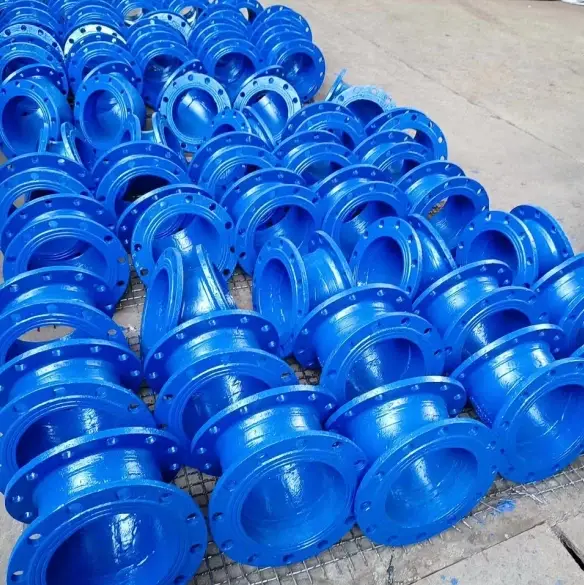Ductile iron pipe fittings play a crucial role in ensuring safe and efficient fluid transportation, and understanding the difference between EN598 and EN545 is key for selecting the right solution. EN598 focuses on pressurized systems with stringent hydraulic performance and leak-tight characteristics, while EN545 is designed for gravity-based drainage and sewer applications that prioritize external load resistance and durability.

Key Differences
-
Application and Pressure Requirements
-
EN598:
This standard is typically used for ductile iron pipe fittings designed for pressurized water distribution systems. It emphasizes rigorous hydraulic performance, including internal pressure resistance, leak tightness, and stability under sudden pressure surges. Fittings manufactured under EN598 are therefore optimized for networks that must maintain integrity under high-pressure conditions. -
EN545:
Fittings following EN545 are generally intended for non-pressure or low-pressure systems such as gravity-based drainage and sewer networks. The standard focuses more on the mechanical performance under external loads (for example, earth cover and traffic loads) rather than internal hydraulic pressure.
-
-
Design and Structural Performance
-
EN598:
Because these fittings are designed for pressurized applications, their design criteria include tighter dimensional tolerances, more robust sealing characteristics, and thorough testing under simulated operating conditions. This ensures that they can sustain high internal pressures and dynamic loads without compromising the integrity of the water network. -
EN545:
For fittings in drainage and sewer systems, the emphasis is on structural integrity against static and dynamic external forces. While durability remains key, the design requirements are less demanding in terms of internal pressure ratings and leak-proof performance under high-pressure conditions. Instead, they concentrate on long-term resistance to the combined effects of soil pressure, traffic load, and environmental exposure.
-
-
Testing and Certification Criteria
-
EN598:
In addition to standard mechanical tests (such as impact and bending tests), EN598-compliant fittings undergo rigorous hydraulic pressure testing. These tests verify that the fittings remain leak-free and maintain proper sealing even under rapid pressure changes and high-pressure environments. -
EN545:
Testing under EN545 is primarily focused on the behavior of the fittings when subjected to external loads. Although mechanical tests such as impact resistance and durability are included, the emphasis on hydraulic pressure performance is not as critical as it is for EN598.
-
-
Installation and Connection Methods
-
EN598 Fittings:
These are often associated with jointing techniques that ensure a secure, pressure-tight assembly. Special attention is given to the quality of sealing elements and the precision of connection interfaces so that the water distribution system performs reliably over its service life. -
EN545 Fittings:
While reliability is still important, the fitting design under EN545 often allows for more tolerance in connection methods where the primary challenge is resisting external loads. This may translate into differences in the joint design and materials used for sealing, depending on the specific environmental exposure (e.g., thermal expansion, chemical attack).
-
Comparative Table
| Aspect | EN598 | EN545 |
|---|---|---|
| Primary Application | Pressurized water supply and distribution systems | Gravity-based drainage, sewer, and low-pressure systems |
| Design Focus | Hydraulic performance, pressure resistance, leak-tightness | Structural integrity under external loads (earth/traffic) |
| Testing Requirements | Rigorous internal pressure tests and dynamic load simulation | Mechanical durability tests focused on external loading |
| Connection Methods | Precision jointing with enhanced sealing for pressure tightness | Standard jointing techniques suited to non-pressurized applications |
| Use Environment | Systems with high internal pressure and dynamic hydraulic demands | Systems where external loads and environmental exposure are the main concerns |
Conclusion
In summary, the difference between ductile iron pipe fittings EN598 and EN545 lies chiefly in their intended service conditions and the corresponding design and testing criteria:
-
EN598 fittings are engineered for pressurized systems where high hydraulic performance is essential. They are ideal for water distribution networks that experience high internal pressures and rapid pressure variations.
-
EN545 fittings are designed for gravity or low-pressure environments, emphasizing long-term durability under external mechanical loads rather than internal pressure challenges.
Understanding these distinctions helps in selecting the proper fitting type for a specific network, ensuring both optimal performance and compliance with the relevant European standards.
References:
- EN 545: Ductile Iron Pipes, Fittings and Accessories for Water Pipelines – European Committee for Standardization (CEN)
- EN 598: Ductile Iron Pipes, Fittings, Accessories and their Joints for Pressure Pipelines – European Committee for Standardization (CEN)
- European Commission – European Standards Overview
- Ductile Iron Pipe – Wikipedia
- ISO 2531: Ductile Iron Pipes, Fittings, and Joints – International Organization for Standardization (ISO)
